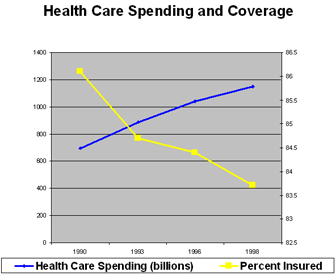|



The University of Michigan
555 South Forest Street
Third Floor
Ann Arbor, MI 48104-2531
T 734-936-9842
F 734-998-6341
/
|
 |
 |
Rising Health Care Costs Frustrate Efforts to Reduce Uninsured Rate THE PROBLEM
The number of people without health insurance in the United States could rise by 8 million people during the next decade if health care costs continue to increase at the rates they have in recent years, according to new research funded by the Economic Research Initiative on the Uninsured (ERIU).
A study by economists Michael Chernew, Ph.D., from the University of Michigan, David Cutler, Ph.D., from Harvard, and Patricia Keenan, Ph.D., from Yale, estimates that nearly two-thirds, or 64%, of the decline in health coverage rates during the 1990's is attributable to rising health care costs. Despite the robust economy during much of the 1990s, health care spending and the average cost of a health insurance premium increased by more than 50 percent, while the percentage of people with health insurance declined steadily.
As health insurance premiums increased, some employers stopped offering insurance. Other employers shifted more of the premium to the workers, leading to higher prices and more workers declining offers. Chernew, Cutler, and Keenan's research shows that for each 1 percent increase in premium rates, over 150,000 more people become uninsured. Unless policies address the rising cost of health care and health insurance, Chernew and others warn that it will become increasingly difficult to reduce the number of uninsured people in the United States. The research helps to explain the paradox of rising uninsured rates during an era of record economic growth and a strong job market.
|
|
Economic theory suggests that health insurance will actually become more valuable when the cost of health care goes up, because the financial risk from not having coverage increases. The problem, though, is that this more costly care can drive up premiums to the point where the price of coverage is simply too high for many people. A family may value the financial protection and access to health care that insurance provides, but for many families, the dollars spent on insurance compete with the dollars needed to meet basic needs. With ever increasing health care costs, the tradeoffs are becoming too high for more and more low- and middle-income families, even those with greater health care needs.
From Catherine McLaughlin,
Ph.D., Professor at the University of Michigan and Director of
ERIU |
THE FACTS
-
Premiums went up, and coverage went down. During the 1990's, the average cost of a health insurance premium rose by about 53 percent, or over $800 inflation-adjusted dollars. Spending on health care increased even more, by 57 percent. Over this same decade, the number of uninsured Americans rose from 34.7 million to 42.6 million, a 23-percent increase.
-
Uninsured rates increased even in economic boom times. The nation's gross domestic product increased by between 3 and 5 percent each year during the 1990's, while unemployment continually hit new lows and real wages jumped 20 percent. Despite this growth, the number of uninsured Americans increased by nearly 8 million during the decade, with the percentage uninsured increasing from 13.9 to 15.4 percent.
-
Gains from strong economy are offset by demographic shifts. The vibrant economy of the 1990s increased coverage, but growth in the number of female-headed and non-white households counteracted these gains. The decade saw larger population gains for groups more likely to lack coverage, including workers earning low wages, those with low education levels, blacks, Hispanics, and the unmarried.

Q&A with Michael Chernew, Ph.D.
Michael Chernew is Professor at the University of Michigan in the departments of Health Management and Policy, Internal Medicine, and Economics. Chernew, who focuses his research on assessing the impact of managed care on the health care marketplace and on health care cost growth, recently co-authored a paper, "Increasing Health Insurance Costs and the Decline in Insurance Coverage," for ERIU.
Q: Can you highlight for me the conundrum between prosperous economic times and the continued decrease in health insurance coverage?
A: People think of prosperity as a time when more people have jobs and would expect insurance rates to rise and uninsurance rates to fall. The 1990s was about as prosperous a time as we've had, but we didn't see a big increase in the number of Americans with health insurance coverage. If the economy isn't generating more coverage when it is doing really well, what will happen when the economy is not doing so well? Moreover, much of the discussion about the problem of the uninsured focuses on what's going on at a point in time and doesn't put the issue in the broader context of rising health care costs. It's extremely important for policymakers and others to understand that debates about the health care system and coverage are occurring against the backdrop of a system that has historically experienced a rate of cost growth significantly above that of GDP. To succeed, policy remedies not only need to look good when they are adopted but also five, ten years down the road.
Q: At what rate have per-capita medical costs been rising since the beginning
of the current decade?
A: Per capita health care costs have been rising 7-plus percent annually since the year 2000. Annual premium increases have even been up in the double digits. In the last few years, even when you take out the increase due to inflation and population growth, you end up with a number higher than 3 percent, which is what we use for the high-end estimation. I think going forward in the near term, we'll continue to see this net annual cost growth of 3 percent.
Q: So as you demonstrate, coverage declines when medical costs and health insurance premiums go up. Did employers drop offers of health insurance? Did they essentially push more of the increased premiums onto workers, who in turn said I can't afford it and will go without?
A: Our research doesn't speak directly to that. In the 1990s, it was workers turning down coverage because they were asked to pay a greater share of the premiums. When employers raise the amount individuals have to pay out of pocket, there will be some subset of individuals who will opt not to participate in their employer's plan. I'm sure there are some employers who decide not to offer coverage as well, but I haven't looked at that in particular. New firms may also be increasingly less likely to offer coverage. Clearly, though, people are responsive to the amount of money they have to pay.
Q: What is the takeaway message for policymakers?
A: There are two messages. First, efforts to subsidize coverage so people can afford it will be difficult to maintain in the long run because the subsidies will either become less effective or more expensive. I think any remedy you pick to deal with the uninsured is going to be viewed differently when rising health care costs are taken into account more explicitly. Secondly, we need to focus more attention on health care financing and developing systems to ensure we get value for the dollar. Spending more on health care is not inherently bad--we get a lot of services for what we spend and we want people to be healthy. With that said, we do want to make sure that the money we are spending is giving us value, and it's not clear that we are getting enough value to justify the dollars being spent. Thinking about insurance design issues is fundamentally important.
Full
Q&A with Michael Chernew, Ph.D.
|
UPCOMING
|
This Research Highlight is the 10th in a series of research-based policy documents that will address current questions and issues related to the health care coverage debate. The next Research Highlight will examine the effect of job changes on loss of coverage. Research Highlights can be found on ERIU's website at . |
Other ERIU Research Highlights
Summary of findings, data, and methods
ERIU Working Paper #8 (Adobe PDF)

Back to top

Funded by The Robert Wood Johnson Foundation, ERIU is
a five-year program shedding new light on the causes and consequences
of lack of coverage, and the crucial role that health insurance plays
in
shaping the U.S. labor market. The Foundation does not endorse the findings
of this or other independent research projects.
|
